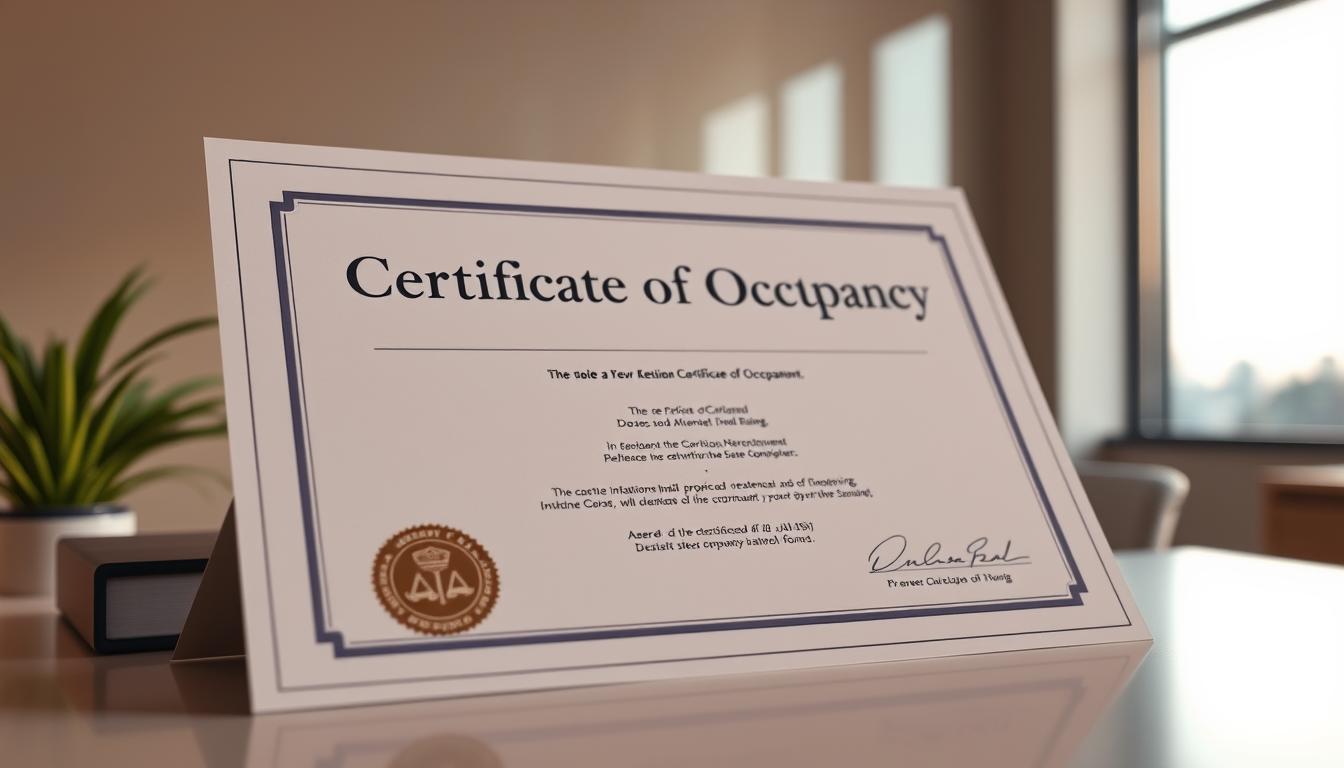Understanding real estate means knowing about key documents. The certificate of occupancy is a top one for safety and rules. New Homes Alberta sees it as a must for property owners, buyers, and renters in Canada.
A certificate of occupancy proves a property is safe and follows local rules. It’s a key permit that shows a building is ready for people to live in or use. This is important because it makes sure the building meets all safety codes.
When a property changes a lot, like through big updates or new builds, a certificate of occupancy is needed. It helps keep everyone safe and avoids legal issues when buying or selling property.
Key Takeaways
- Critical legal document for property safety and compliance
- Required for major property changes and ownership transfers
- Protects buyers, tenants, and real estate investors
- Essential for mortgage approvals and lease agreements
- Validates structural integrity and code adherence
Understanding the Basics of Occupancy Certificates
A certificate of occupancy is a key document in real estate and construction. It shows a building is safe and follows local laws. This important paper makes sure buildings meet strict building codes and zoning rules before they can be used.
Definition and Core Purpose
A certificate of occupancy confirms a building meets safety and legal standards. Property owners need this to:
- Legally sell or rent a property
- Open a business in a new location
- Show they follow local building rules
- Check if the property’s use fits municipal rules
Legal Significance
The legal value of a certificate of occupancy is huge. Not having it can lead to big problems, like fines, legal trouble, and issues with selling or renting. Local authorities use these certificates to keep everyone safe and follow community building rules.
Core Components
A typical certificate of occupancy has important details like:
- Complete property address
- Property owner’s name
- Specific occupancy classification
- Construction details
- Inspection dates and results
A certificate of occupancy is your property’s official “passport” to legal use and occupancy.
What is a Certificate of Occupancy
A certificate of occupancy is a key document in construction and real estate. It shows that a building meets all the rules and safety standards. This is needed for a building to be legally occupied.
This document is important for safety and following local rules. Before a building can be used, the owner must get this certificate.
- Issued for new construction projects
- Required for buildings with changed use or significant renovations
- Validates construction compliance with local building codes
- Confirms the safety of the property for occupants
There are different types of certificates for different situations. Construction compliance is key in getting these certificates. Cities need different certificates for:
- Residential properties
- Commercial buildings
- Renovated spaces
- Repurposed structures
Getting a certificate of completion is a step towards getting the final certificate. Inspectors check the property to make sure it’s safe and meets all rules.
A certificate of occupancy is more than just paperwork – it’s a guarantee of safety and compliance for property owners and occupants.
Investors and homebuyers need to know this document is vital. It shows the building was built or changed according to local laws and is safe.
Legal Requirements and Compliance Standards
Understanding the legal side of property occupancy is complex. It involves building permits, zoning rules, and safety checks. These are key to making sure a property meets legal standards.
Local governments have strict rules to protect everyone. The Certificate of Occupancy proves a building meets all legal needs.
Building Code Requirements
Building codes are detailed rules for safety and structure. They cover many areas, like:
- Structural design and stability
- Electrical system standards
- Plumbing and mechanical specifications
- Material quality and durability
Zoning Regulations
Zoning rules decide how properties can be used. They keep communities in order and stop bad land uses. You need to follow these rules to get building permits.
Safety Standards
Safety checks are vital to ensure a property is safe. Experts do detailed checks to make sure:
- Fire safety systems are working
- Accessibility standards are met
- Structural parts are safe
- Environmental dangers are reduced
Following these rules helps property owners avoid fines, legal trouble, and safety issues.
Types of Occupancy Certificates
Understanding certificates of occupancy can be tricky. There are different types for various property uses and conditions. Knowing these helps ensure legal compliance for both homes and businesses.
Property owners face several key types of occupancy certificates:
- Permanent Certificate of Occupancy (PCO): Given for buildings fully finished and meeting all rules
- Temporary Certificate of Occupancy (TCO): Good for 90 days, can be renewed after a check
- Zoning Certificate of Occupancy: Needed when changing a property’s use (like turning a store into a restaurant)
For homes, certificates check if a building is safe and follows zoning rules. Commercial buildings need more checks, like:
- Plumbing systems
- Fire sprinkler systems
- Fire alarm systems
- Electrical systems
- Architectural compliance
Some cases need special certificates. For small changes, a Letter of Completion might be given. Older buildings might get a Letter of No Objection.
Knowing the right certificate can save owners a lot of time and avoid legal issues.
The Application Process for Obtaining a CO
Getting a certificate of occupancy (CO) needs careful planning. Property owners must know the steps to get this important document. It’s key for building permits and safety checks.

The first step is to prepare well and know the local rules. Each area has its own rules to follow closely.
Required Documentation
To apply for a CO, you need a lot of paperwork. Here’s what you should have:
- Proof of property ownership
- Detailed building layout plans
- Business certification documents
- Authorization from the building owner
- Completed occupancy permit application form
Inspection Procedures
Safety checks are a big part of getting a CO. Local officials will check your building to make sure it meets safety standards.
| Inspection Type | Focus Area | Typical Duration |
|---|---|---|
| Structural Assessment | Building integrity | 2-3 hours |
| Fire Safety Review | Emergency systems | 1-2 hours |
| Electrical Verification | Wiring and electrical systems | 1-1.5 hours |
Timeline Expectations
Plan ahead when applying for a CO. It usually takes 3-6 weeks. This depends on how complex your project is and how fast the local government works.
- Submit your application 3 weeks before you want to start using the building
- Be ready for extra checks from other agencies
- Set aside money for fees (about $300)
- Have all your documents ready to go
Being well-prepared and talking to local building officials can make getting a CO easier.
Cost Breakdown and Fee Structure
Getting a certificate of occupancy comes with different fees. These fees change based on the property type, location, and project size. Owners need to get ready for various costs when they apply for building permits and occupancy certificates.
The cost for a certificate of occupancy includes several main parts:
- Building permit fees
- Inspection charges
- State and local surcharges
- Technology and administrative fees
Permit costs can vary a lot. Small projects might need permits from $50 to $300. But, bigger projects could face fees from $500 to $2,000. On average, building permits cost about $477.
Different permits have their own fee systems:
- Electrical permits: $50 to $350
- Plumbing permits: $30 to $500
- Deck permits: $50 to $150
- Construction permits: $500 to $2,000
There are also extra fees like technology surcharges (3%), planning fees (5%), and state surcharges (1-3%). Owners should plan for these extra costs when applying for an occupancy permit.
Always confirm exact fees with local municipal authorities, as rates can change annually.
A standard certificate of occupancy usually costs about $50. There’s also a 2% state levy. Owners should expect to pay more based on their project needs.
Common Reasons for Certificate Denial
Getting a certificate of occupancy can be tough for property owners. Building departments are very strict. They check for construction compliance and safety to keep everyone safe and follow rules.
If a property doesn’t meet important standards, local authorities might not give the certificate. Knowing what can block you helps property owners deal with the complex permitting process better.
Building Code Violations
Building code violations are a big problem for getting a certificate of occupancy. These issues can be:
- Structural integrity problems
- Wrong electrical systems
- Bad plumbing setups
- Architectural designs that don’t follow rules
Safety Issues
Safety checks are key to getting a building permit. Safety problems that might stop you from getting a certificate include:
- Not enough fire protection systems
- Unstable foundations or weak structures
- Not enough emergency exits
- Possible environmental dangers
Documentation Problems
Paperwork is very important for following construction rules. Common paperwork issues that can cause delays or stop you from getting a certificate are:
- Not fully filled out permit applications
- Missing inspection reports
- Incorrect architectural plans
- Not submitting needed certifications
Talking well with local building departments and being very careful with details can really help you get a certificate of occupancy.
Property Sales and Certificate Requirements
A certificate of occupancy is key in property deals. It shows a property is ready for living or business use. This document is vital for selling a property.
This document is more than just a form. It tells buyers the property is safe and meets building codes. Without it, selling a property can be hard.
- Sellers must get a valid certificate of occupancy before selling
- Buyers need it to get a mortgage
- It shows the property follows local building rules
To get a certificate, a property gets checked thoroughly. Experts look at:
| Inspection Areas | Key Requirements |
|---|---|
| Structural Integrity | Meets building code standards |
| Safety Systems | Smoke and carbon monoxide alarms work |
| Mechanical Systems | Plumbing and electrical are working |
Getting a certificate of occupancy costs money. Prices are $100 to $260, usually paid by the seller. Without it, you might face fines and can’t sell the property.
Pro tip: Always check with local building departments for specific certificate needs.
For homes and businesses, the certificate of occupancy is more than a piece of paper. It’s proof the property is safe and legal in the real estate world.
Commercial vs Residential Certificates
Understanding property certificates can be tricky, mainly when it comes to commercial and residential needs. Knowing the differences helps owners and investors make smart choices about their properties.
Certificates of occupancy are key in both commercial and residential areas. Each has its own rules and regulations. Zoning laws are a big part of what makes these certificates different.
Business Requirements for Commercial Occupancy
Getting a commercial occupancy certificate is more complex than for homes. Businesses need to meet strict rules to get theirs. These include:
- Comprehensive building code compliance
- Detailed safety system verification
- Specific zoning regulations adherence
- Comprehensive fire safety assessments
Home Occupancy Standards
Residential certificates focus on making sure homes are safe and livable. Homeowners must show their property meets local building codes and zoning rules.
Important things for residential certificates include:
- Structural integrity verification
- Electrical system compliance
- Plumbing and mechanical system inspections
- Overall property safety assessment
Getting the right certificate is key for legal use and protecting your investment.
While both commercial and residential certificates aim for safety and compliance, their needs differ. Talking to local authorities is a good way to understand what you need.
Temporary Certificates and Special Circumstances
Getting an occupancy permit can be tough, mainly when a building isn’t done yet. A Temporary Certificate of Occupancy (TCO) is a big help for owners and builders in tricky situations.
TCOs let buildings be used in part before they’re fully checked. They have rules and limits:
- Valid for up to 180 days
- Needs a refundable bond of $5,000 to $10,000
- Costs $517.00 to get one
- Must pass all safety checks
Getting a TCO involves a few key steps:
- Fill out a detailed TCO application
- Do all needed inspections
- Get final okay from departments
- Make sure the site is clean and safe
- Show proof of following the rules
“A Temporary Certificate of Occupancy bridges the gap between construction and full occupancy, ensuring safety while providing flexibility for property developers.”
For special cases like old buildings or big changes, there are extra rules. Contractors need to keep detailed records, get the right approvals, and follow strict building rules.
Owners should know that not following TCO rules can lead to lost bonds and legal trouble.
Certificate Renewal and Maintenance
Keeping a valid certificate of occupancy is a big job. Property owners must stay on top of it. They need to know how to keep their certification up to date and follow local building rules.

It’s key to keep up with safety checks and building rules. A certificate of occupancy isn’t forever. It needs regular checks and updates.
Renewal Procedures
Renewing a certificate of occupancy involves a few important steps:
- Submit a complete Building Permit Application
- Provide proof of property ownership
- Include a Recorded Act of Sale (if applicable)
- Pay required renewal fees
Ongoing Compliance Requirements
Property owners need to know when to renew their certificate:
- Major property use changes
- Significant building modifications
- Zoning regulation updates
- Property vacancy exceeding six months
The renewal process usually takes one to three days. This depends on if an inspection is needed. Inspections check if the property meets safety and zoning standards.
Being proactive with your certificate of occupancy protects your investment. It also keeps you in line with the law.
If you don’t renew or update your certificate, you could face legal issues. This includes fines or limits on how you can use your property. Keeping up with renewals is essential for smooth property ownership.
Impact on Property Value and Insurance
A certificate of occupancy is key in setting a property’s value and insurance rates. It’s important for property owners to know how it affects their investment.
For homes and businesses, a valid certificate of occupancy brings big financial gains. Properties with a current CO often see:
- Higher resale value
- Better market appeal
- Easier loan approvals
- More insurance options
Without an occupancy certificate, properties face big hurdles. About 65% of buyers are hesitant to buy properties without proper certification. Banks and insurers see these properties as riskier.
Insurance companies check the certificate of occupancy to see if a property is safe. A valid CO can lower insurance costs. It shows the property meets local building and safety rules.
A certificate of occupancy is not just a document—it’s a testament to a property’s legal and structural integrity.
The financial benefits are clear. Properties with all the right documents can see their value go up by 10-15%. This makes the certificate of occupancy a vital asset for investors and homeowners.
Role of Building Inspectors and Officials

Building inspectors are key to keeping construction safe and up to code. They check building permits and do safety checks during building. This ensures buildings are safe and meet standards.
In British Columbia, building officials have to meet high standards. They must join the Building Officials’ Association of British Columbia (BOABC). They also need to pass exams based on their job level.
- Complete annual continuing professional development
- Verify compliance with provincial building regulations
- Conduct thorough safety inspections at various construction stages
- Review documentation and approved construction plans
The Building Act says building officials make sure buildings follow local codes. They check construction projects from start to finish. This includes looking at plans and doing final checks before a building is ready for people to live in.
| Inspection Stage | Key Responsibilities |
|---|---|
| Initial Review | Check zoning compliance and documentation |
| Construction Phase | Verify adherence to approved building plans |
| Final Inspection | Ensure complete construction compliance before issuing occupancy permit |
Builders and property owners must work well with building inspectors. They need to give 24-hour notice for inspections. Keeping open communication is important during the building process.
Conclusion
Knowing what a certificate of occupancy is is key for property owners and investors in Canada. These documents check if buildings are safe and follow the law. New Homes Alberta helps with the complex steps of getting building permits and occupancy permits.
An occupancy permit is more than just a form. It proves a building meets local building codes and safety rules. Without it, you could face big fines, use limits, and sales problems.
If you’re lost in the certificate of occupancy process, help is out there. New Homes Alberta is here to guide you. Our experts can make getting building permits easier and ensure you follow local rules. Call us at (403) 305-9167 for help with your occupancy permit.
By understanding and getting your certificate of occupancy, you save time and avoid legal trouble. It also gives you peace of mind for your property in Canada.





